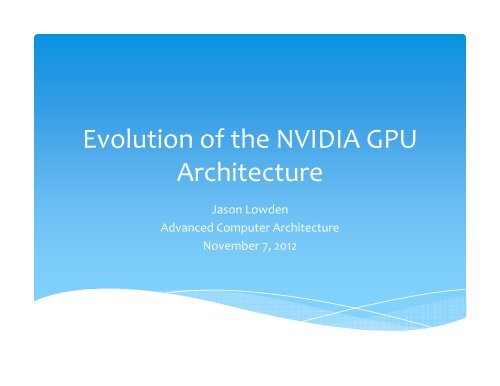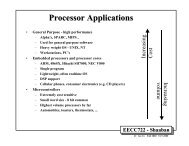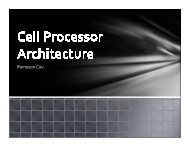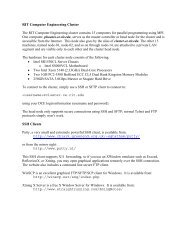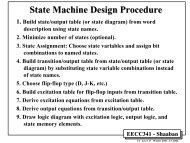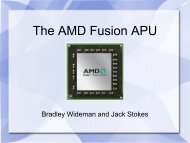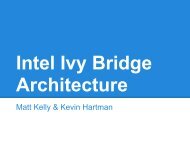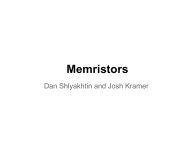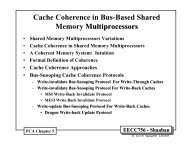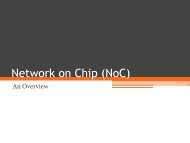Evolution of the NVIDIA GPU Architecture
Evolution of the NVIDIA GPU Architecture
Evolution of the NVIDIA GPU Architecture
Create successful ePaper yourself
Turn your PDF publications into a flip-book with our unique Google optimized e-Paper software.
Graphics Pipeline
Computational Elements <strong>of</strong> a <strong>GPU</strong>∗ Streaming Processor –Core <strong>of</strong> <strong>the</strong> design∗ Place where all <strong>of</strong> <strong>the</strong> computation takes place∗ Streaming Multiprocessor∗ Groups <strong>of</strong> streaming multiprocessors∗ In addition to <strong>the</strong> SPs, <strong>the</strong>se also contain <strong>the</strong> SpecialFunction Units and Load/Store Units∗ Instructional Schedulers∗ Complex Control Logic
Streaming Multiprocessor <strong>Architecture</strong>
Types <strong>of</strong> <strong>GPU</strong> Memory∗ Global∗ DRAM∗ Slowest Performance∗ Texture∗ Cached Global Memory∗ “Bound” at runtime∗ Constant∗ Cached Global Memory∗ Shared∗ Local to a block <strong>of</strong> threads
Architectural Memory Hierarchy
Fermi <strong>Architecture</strong>
Fermi Improvements∗ Increase <strong>the</strong> number <strong>of</strong> SPs per SM∗ Unified Request Path for load/store instructions∗ Implementation <strong>of</strong> a cache hierarchy∗ L1 cache per SM∗ Configurable with Shared Memory∗ L2 cache is shared globally∗ Register Spilling∗ Occurs when <strong>the</strong> register requirements <strong>of</strong> a threadexceed what is available on <strong>the</strong> device∗ Previous Generation: Spill to DRAM (global memory)∗ Fermi: Use <strong>of</strong> <strong>the</strong> L1 cache
Summary
Kepler SM Design15
Warp Scheduler∗ 4 warp schedulers∗ Each scheduler can issue up to 2 independentinstructions when it is ready to issue.16
Kepler Memory <strong>Architecture</strong>∗ Shared Memory and L1 are stillphysically shared∗ New configuration: 32K L1,32K Shared∗ Shared memory bandwidth isdoubled compared with Fermi∗ Increased <strong>the</strong> size <strong>of</strong> L2∗ Doubled <strong>the</strong> size Fermi,increasing it to 1536 KB∗ Introduction <strong>of</strong> Read‐OnlyCache∗ Previously, this was used inFermi for Texture cache∗ 48 KB <strong>of</strong> storage 17
Warp Shuffle Instructions∗ In Fermi, data could only be exchanged between threads using sharedmemory.∗ Resulted in additional synchronization time∗ Kepler allows <strong>the</strong> shuffle functions, which∗ Exchange data between threads without using shared memory∗ Handles <strong>the</strong> store‐and‐load operation as a single step∗ Data can only be shared within <strong>the</strong> same warp∗ In <strong>the</strong>ir example, an FFT algorithm saw 6% performance increase whenusing this instruction.18
Kepler Hardware Features∗ Dynamic Parallelism∗ Any kernel can launch more kernels from within itself∗ Takes additional load <strong>of</strong>f <strong>of</strong> <strong>the</strong> CPU∗ Hyper‐Q∗ 32 hardware managed work queues∗ Fermi had 1 queue∗ Grid Management Unit∗ Needed to manage <strong>the</strong> number <strong>of</strong> grids that are executed∗ Introduction <strong>of</strong> <strong>the</strong> GMU to handle all <strong>of</strong> <strong>the</strong> grids that can be activeat one time∗ <strong>NVIDIA</strong> <strong>GPU</strong>Direct TM∗ Ability for CUDA enabled <strong>GPU</strong>s to interact without <strong>the</strong> need for CPUintervention∗ The <strong>GPU</strong> can interact directly with <strong>the</strong> NIC19
Comparison <strong>of</strong> Kepler and Fermi20
Use for Computation∗ Historically, <strong>GPU</strong>s were used for graphics to <strong>of</strong>floadCPU work∗ Current trend –Combine CPU and <strong>GPU</strong> on a single core∗ Due to <strong>the</strong> massively parallel computations <strong>of</strong> <strong>the</strong>work, <strong>GPU</strong>s are ideal for <strong>the</strong>ir number <strong>of</strong> processingcores.∗ However, <strong>the</strong>se are only ideal when <strong>the</strong>re are few datadependencies.∗ Introduction <strong>of</strong> CUDA and <strong>the</strong> Tesla <strong>GPU</strong>s
CUDA Programming∗ Extensions to <strong>the</strong> C language∗ With some C++ support∗ Programming Support∗ Windows –Visual Studio∗ Linux/Mac – Eclipse∗ Programming paradigm where each computationtake place on a separate thread∗ Requires <strong>NVIDIA</strong> <strong>GPU</strong> for acceleration∗ Simulators are used for research purposes
Example – Vector AdditionCfor( int i = 0; i < SIZE; ++i ) {c[ i ] = a[ i ] + b[ i ];}CUDA__global__ void addVectors( float* a, float* b,float* c ) {int id = threadIdx.x;if( id < SIZE ) {c[ id ] = a[ id ] + b[ id ];}}
Programming Requirements∗ Explicit Memory Operations to allocate and copy datafrom <strong>the</strong> CPU to <strong>GPU</strong>∗ Some exceptions do apply∗ All kernels execute asynchronously <strong>of</strong> <strong>the</strong> CPU∗ Explicit synchronization barriers between <strong>the</strong> processors
Synchronization and Performance∗ To meet data dependencies,∗ Synchronization Primitives∗ __syncthreads() –Synchronizes all threads in a block∗ Atomic Operations –Depending on compute/CUDAversion, <strong>the</strong>se are possible on global and shared memory∗ Performance is dictated by memory operations andsynchronization cost∗ Memory Coalescence∗ Warp Divergence
Relation to O<strong>the</strong>r <strong>Architecture</strong>s∗ SMT∗ Many smaller cores, with less functionality, to compute results∗ Each core has a hardware context for a thread that can beswitched out∗ Vector Processors∗ Computation <strong>of</strong> results in parallel that could be donesequentially by a CPU∗ Ability to access large chunks <strong>of</strong> data from memory at a giventime∗ Banks <strong>of</strong> shared memory ‐ could lead to bank conflicts∗ Digital Signal Processors∗ As with DSP algorithms, many applications could also use <strong>the</strong>MAC elements; <strong>the</strong>se are built into <strong>the</strong> <strong>GPU</strong> by design
Conclusions∗ <strong>GPU</strong>s are massively parallel devices that can be used forgeneral purpose computing, in addition to graphicsprocessing∗ As <strong>the</strong> cost continues to decrease, <strong>the</strong>se devices become<strong>of</strong>f‐<strong>the</strong>‐shelf components that can be used to build largersystem.∗ In addition to compute capabilities, Kepler <strong>of</strong>fers <strong>the</strong>benefit <strong>of</strong> additional performance per watt, making a morepower efficient design.∗ When used with o<strong>the</strong>r technologies, like OpenCL, <strong>GPU</strong>s canbe used in heterogeneous platforms.
References∗∗∗∗∗∗∗http://www.nvidia.com/page/corporate_timeline.htmlhttp://www.pcmag.com/encyclopedia_term/0,2542,t=graphics+pipeline&i=43933,00.aspS. L. Alarcon, “CUDA Memories,” unpublished.<strong>NVIDIA</strong>. (2012 April 16). <strong>NVIDIA</strong> CUDA C Programming Guide. [Online]. Available:http://developer.download.nvidia.com/compute/DevZone/docs/html/C/doc/CUDA_C_Programming_Guide.pdf.<strong>NVIDIA</strong>. (2009). <strong>NVIDIA</strong>’s Next Generation CUDA TM Compute <strong>Architecture</strong>: Fermi. [Online].Available:http://www.nvidia.com/content/PDF/fermi_white_papers/<strong>NVIDIA</strong>_Fermi_Compute_<strong>Architecture</strong>_Whitepaper.pdf.<strong>NVIDIA</strong>. (2012). <strong>NVIDIA</strong>’s Next Generation CUDA TM Compute <strong>Architecture</strong>: Kepler TM GK110.[Online]. Available: http://www.nvidia.com/content/PDF/kepler/<strong>NVIDIA</strong>‐Kepler‐GK110‐<strong>Architecture</strong>‐Whitepaper.pdf.<strong>NVIDIA</strong>. (2012). <strong>NVIDIA</strong> GeForce GTX 680. [Online]. Available:http://www.geforce.com/Active/en_US/en_US/pdf/GeForce‐GTX‐680‐Whitepaper‐FINAL.pdf


